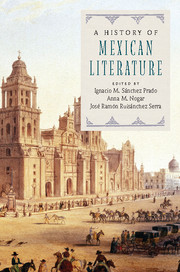Book contents
- Frontmatter
- Contents
- List of contributors
- Introduction
- PART I COLONIAL LITERATURE
- PART II THE NINETEENTH CENTURY
- 9 Early Nineteenth-Century Nation-Building Prose
- 10 The Emergence of the Mexican Literary Field (1833–1869)
- 11 The Rise of Cultural Institutions
- 12 Liberal Literat
- 13 The Conservative Paradigm
- 14 Mexican Modernismo
- PART III TWENTIETH AND TWENTY-FIRST CENTURIES
- PART IV MEXICAN LITERATURE BEYOND BOUNDARIES
- Index
- References
11 - The Rise of Cultural Institutions
from PART II - THE NINETEENTH CENTURY
Published online by Cambridge University Press: 05 July 2016
- Frontmatter
- Contents
- List of contributors
- Introduction
- PART I COLONIAL LITERATURE
- PART II THE NINETEENTH CENTURY
- 9 Early Nineteenth-Century Nation-Building Prose
- 10 The Emergence of the Mexican Literary Field (1833–1869)
- 11 The Rise of Cultural Institutions
- 12 Liberal Literat
- 13 The Conservative Paradigm
- 14 Mexican Modernismo
- PART III TWENTIETH AND TWENTY-FIRST CENTURIES
- PART IV MEXICAN LITERATURE BEYOND BOUNDARIES
- Index
- References
Summary
Although perhaps overidentified as the historical birth of liberal Mexico, 1867 was a pivotal year for the nation. It marked not only the victory spearheaded by liberal leader Benito Juárez and the capitulation of the so-called Maximilian Affair, but also the turning point of a major institutional overhaul that favored the idea of a federalist, secular, market-driven nation over the centralist, theocratic, and corporatist vision of the conservatives. Given that the patriotism espoused by midcentury liberal ideologues, journalists, and statesmen such as Francisco Zarco (1829–1869) and Ignacio Ramírez (1818–1879) had been defined for decades from a position of dissent or rebellion, the transition to a reconciled, constructive position following the 1867 triumph was both fueled by the optimism of victory and fraught with the constant challenges of creating consensus on policy overhauls.
Leading up to 1867, one key point of historical contention between liberals and conservatives involved their conflicting attitudes regarding the boundaries of church and state. In 1856, Secretary of the Treasury Miguel Lerdo de Tejada passed the controversial Ley Lerdo, which forced the church to sell its enormous uncultivated landholdings, thus removing what was perceived as one of the greatest obstacles to national growth. This move initiated a large-scale shift from church to polity that would upset Mexican society at the foundational level. Because it also entailed divesting the church of its hold on education as well as expropriating material possessions such as books, artworks, and edifices that later became framed and promoted as national patrimony, the separation of church and state played a pivotal role in the secular public institutionalization of Mexican culture.
Although similar proposals had circulated among liberal statesmen two decades earlier (Wheat, 1957: 58), the connections among property, the idea of rightful ownership, and the major cultural institutions of the late nineteenth and early twentieth centuries solidified after 1850. That year, Zarco specifically linked the idea of a redistribution of cultural and intellectual property to Mexico's emergent cultural autonomy and advocated for the elimination of commercial, scientific, artistic, and educational “monopolies” that had stunted national development during the three hundred years of colonial occupation (El Siglo Diez y Nueve, May 25, 1850).
- Type
- Chapter
- Information
- A History of Mexican Literature , pp. 171 - 187Publisher: Cambridge University PressPrint publication year: 2016



